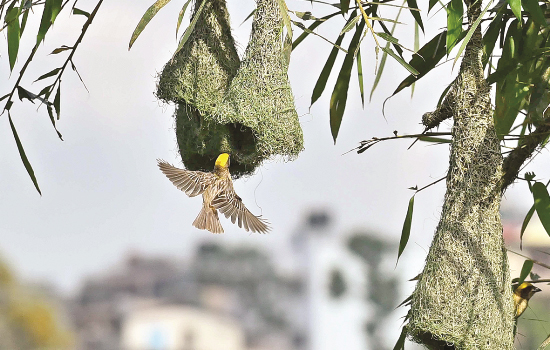Lockdown boosts bird population in Kathmandu

By Aashish Mishra
Kathmandu, June 17: The lockdown shall be associated with a lot of things – raging coronavirus pandemic, thousands of people in quarantine, economic hardships and the disruption of normal life. But the one thing it might not be associated with is birds.
As the hustle and bustle of Kathmandu’s hectic life came to a grinding halt, the melodious chirping of birds rang up in the capital’s atmosphere. Mynas could be heard singing while swallows entered people’s homes and gardens for the first time after a long time. But how come the birds suddenly became so visible during the lockdown?
According to ornithologist Dr Hem Sagar Baral, it is because their population grew during this period. “The low pollution and lack of human disturbance that we saw during the lockdown allowed bird numbers to go up,” he said.
What further helped Kathmandu’s avian population is that the lockdown coincided with the birds’ breeding season. “The spring and summer seasons are when birds lay their eggs, hatch them and raise their young,” Dr Baral informed. “This year, they could breed without any hindrance.”
The lockdown also provided them with ample space to build their nests. In addition to trees, something sorely lacking in the city centre, they could also use buildings like hotels, schools and offices which were closed and empty for their nesting.
Furthermore, the quiet atmosphere encouraged some birds like the Common Tailor Bird, Dove and Red-Vented Bulbul to breed twice, according to Baral. “When there is plenty of food, clean air, no noise and minimal disturbance, some small birds attempt second breeding,” he said, adding, “The peace and tranquillity created by the total shutdown allowed them to breed twice, further increasing the bird population.”
And that is not all. As Hari Basnet, bird biodiversity and avian ecology expert, explained, the safety offered by the lockdown also attracted many birds from outside. Places like the Tribhuvan University’s compound, Godawari, Chandragiri, Narayanhiti, Swayambhu, Ranibari and other tree-covered areas are suitable habitats for birds inside the valley. But these places are often crowded with people throwing stones, shaking trees and scaring away the birds. The lockdown has put a stop to this, so birds from surrounding areas and forests are coming to Kathmandu, he said.
The reduction in noise pollution has also served to invite birds, Dr Baral believed. Birds mainly communicate through sound but normally other louder sounds of the city drown them out. During the lockdown, though, there were no vehicles, no factories and no construction activities, meaning that the city was mostly quiet. This allowed the birds to communicate without strain, he shared.
Moreover, Dr Baral also felt that people are paying more attention to birds. “The lockdown has brought people closer to nature,” he said. “With very little to do, they come out and see the bird sitting on their windowsill, the butterfly flying around their garden or the flower blooming in the vase on their roof.”
He added, “This is all very new and mesmerising to us city dwellers and we talk about it and share it with others. The birds were there but we just didn’t notice them as much.”
Baral is encouraged by how appreciative people have become of the nature around them, but he does not think that it outlast the lockdown. “As the restrictions are lifted, Kathmandu will go back to its old ways,” he opined. “But I do think that nature, and birds, will always get some space in most people’s hearts.”
Recent News

Do not make expressions casting dout on election: EC
14 Apr, 2022
CM Bhatta says may New Year 2079 BS inspire positive thinking
14 Apr, 2022
Three new cases, 44 recoveries in 24 hours
14 Apr, 2022
689 climbers of 84 teams so far acquire permits for climbing various peaks this spring season
14 Apr, 2022
How the rising cost of living crisis is impacting Nepal
14 Apr, 2022
US military confirms an interstellar meteor collided with Earth
14 Apr, 2022
Valneva Covid vaccine approved for use in UK
14 Apr, 2022
Chair Prachanda highlights need of unity among Maoist, Communist forces
14 Apr, 2022
Ranbir Kapoor and Alia Bhatt: Bollywood toasts star couple on wedding
14 Apr, 2022
President Bhandari confers decorations (Photo Feature)
14 Apr, 2022









